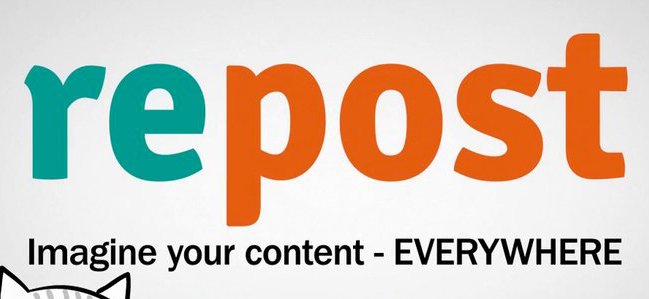Repost Shuts Down & How Article Embedding Can Still Grow
 Recently, Repost announced that they were closing down. The service, formerly known as Repost.Us, originally launched in March of 2011 and the company was involved in article embedding, through Clp.ly, since mid-2010.
Recently, Repost announced that they were closing down. The service, formerly known as Repost.Us, originally launched in March of 2011 and the company was involved in article embedding, through Clp.ly, since mid-2010.
Repost made it easy for bloggers and others to make their text content available for embedding on other sites. Article embeds not only ensured that attribution was carried with the article, but also made the views trackable and opened the door to advertisements and other revenue opportunities.
According to Repost’s announcement, they served some 8,500 sites, had 8 million articles in their system and served content to over 100,000 domains. However, “Although the technology worked well, the business model didn’t,” the announcement said. Since they were unable to raise additional funding, they’ve decided to close the service.
If you’re a Repost user, as I was, it’s important to note that the service has already stopped allowing users to log in to their accounts. New embeds have also been disabled and new content is not being ingested into the service. On July 31, 2014 the API servers will be shut down and all currently embedded content will cease to be available though the s.tt URL shortener will remain active through the end of the year.
They have already updated their scripts to remove the Repost buttons from the sites they appeared on, though it’s likely a good idea to go ahead and remove any plugins or code.
The field of article embedding, unfortunately, is a graveyard. Prior to Repost, Embed Anything closed its doors in November of 2012, Voxant Newsroom, launched in 2008, switched to offering only video content and now seems to no longer be in operation at all (it’s domain forwarding to a blog) and they are far from the only ones.
But as we say goodbye to Repost and its similar services, what does the future of content embedding look like? The answer is pretty bleak, but there is one possibility that could change the game.
The Problem with Content Embedding
 For multimedia content, embeds are second nature. Whether we are embedding a YouTube clip, a SoundCloud file or Pin from Pinterest, the Web is filled with people who are grabbing embed codes and putting them in their sites and profiles without a second though. It’s perfectly natural.
For multimedia content, embeds are second nature. Whether we are embedding a YouTube clip, a SoundCloud file or Pin from Pinterest, the Web is filled with people who are grabbing embed codes and putting them in their sites and profiles without a second though. It’s perfectly natural.
With text though, it’s a different story. Though embedding articles has many of the same benefits as it does with multimedia content, text is usually just copied and pasted directly, often without attribution, inbound links or any means for the author to reap reward from his or her work.
There are three reasons that this is the case:
- Habit: People were used to copying and pasting text long before the Internet. It’s a tough habit to break, even when better alternatives exist.
- Technological Issues: Videos, images, audio files, are all easily controlled and fairly standard in terms of size and appearance. Every article is different in terms of length, formatting, etc. Couple that with countless platforms for publishing text and it is nearly impossible to build a system that can function universally like a YouTube embed can.
- Business Model: As Repost indicated, it’s tough to make money as a middle man for text-based content. Though there are many licensing agencies out there specialized in offering paid embeds, turning a profit as a middle man for free embeds is a tricky task.
As a result, companies that have entered this field have struggled and even those, like Repost, with effective solutions have not been able to carve out a niche for themselves.
But as frustrating as that is for people like myself who would like to see article embedding come to light, all hope is not lost.
Changing the Thinking on Embeds
If we shift the way we look at the idea of “embedding”, something strange becomes obvious: Millions of people are embedding text-based content every day already.
However, it’s not called embedding. On Tumblr and Wordpress.com, it’s called Reblogging, on Twitter it’s called Retweeting, on Facebook it’s called Sharing and the list goes on.
While it might not seem like embedding, the function is much the same. A text post, no matter how short, is placed in another person’s profile/site with attribution and some level of tracking.
Use of these tools are already widespread, familiarity and comfort with them are high and the technology is already built. The only limitation is that these services don’t work outside of their various walled gardens. You can’t reblog a WordPress.com post on Tumblr or vice versa.
However, this could be easily solved by offering embed codes, similar to what YouTube offers and Repost did offer, to enable embedding on other services.
But as useful as such an addition would be, it would defeat one of the key purposes of these tools, namely to reinforce the walls around these services. Reblog and sharing buttons are designed to build the internal community and keep it internal. It gives those who sign into Tumblr or WordPress.com a built-in and exclusive audience they can reach out to.
Still, this hasn’t stopped some from reaching out. Twitter, for example, offers embedded tweets and it has become a popular feature for blogs and news sites to use. However, other blogging platforms offer no such alternatives.
Automattic, for example, doesn’t offer a way to embed posts in WordPress.com. However, if they were to do so, and take advantage of Jetpack to bring the feature to self-hosted sites, it could be a major coup for WordPress-hosted blogs. Similarly, the ability to bring Tumblr-hosted content into third-party sites could also help Tumblr users reach an even larger audience.
But while this may be in the best interest publishers, it’s not always in the best direct interest of companies operating the services, which want outsiders to join to have access to the audience and the content contained within.
However, this is the only way that the embedding of articles is likely to become viable. Video embeds didn’t become common because of a third party, they became common because YouTube, the host, offered them. The same is true for Soundcloud, Pinterest and others.
What bloggers and other writers need isn’t an intermediary to enable embedding, but rather, their hosts to become that intermediary. Even if it isn’t a great stand alone business model, it can be a great way for hosts to stand out and offer their users even more.
Bottom Line
Historically, those who have tried to solve the problem of embedding articles have tried to do so in a strange way, by putting a third party between the author and the site wanting to embed the content. But as embeds for other types of content have shown, that initiative usually best comes from the hosts of the content, not an outside party.
Still, Repost and Embed Article have shown two critical things: That article embedding can work from a technology standpoint and that there is at least some interest in doing it. It’s up to the hosts of the content to try and bridge that gap.
However, the issue of article embedding centers around a larger one: The issue of walled gardens. While walled gardens online aren’t bad by themselves, they do limit the audience of the people who post and seek an audience behind them. This can be useful for certain types of content, but less useful for bloggers hoping to reach the largest audience possible.
Embedding allows hosts to punch strategic holes in these walls that ensure those inside the garden can reach the ouside audience, but that the audience they find can be led back in. That, in turn, is better than the common alternative, blindly copying and pasting content, often with little interest in attribution.
Article embedding can be a win-win for everyone, if hosts are able to take the initiative.
Want to Reuse or Republish this Content?
If you want to feature this article in your site, classroom or elsewhere, just let us know! We usually grant permission within 24 hours.
